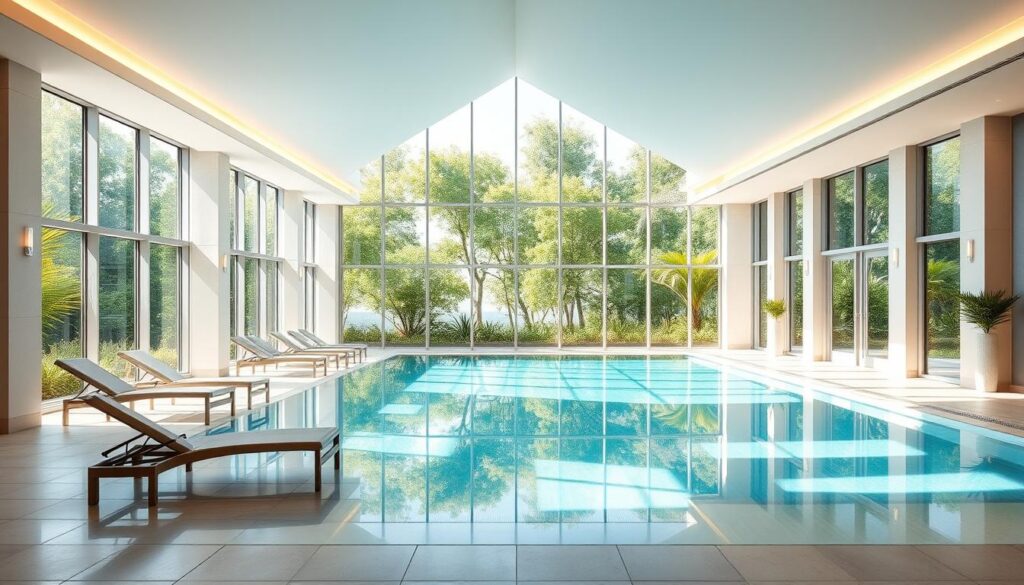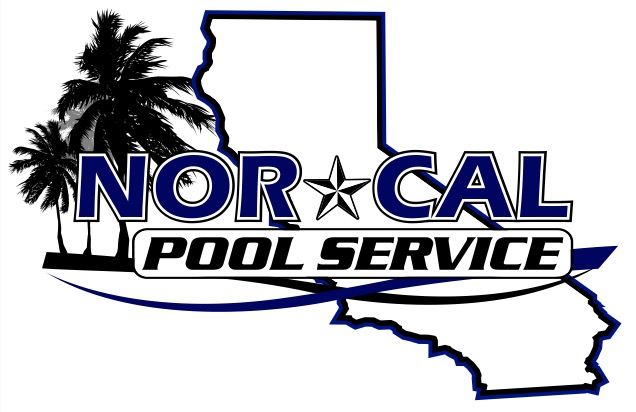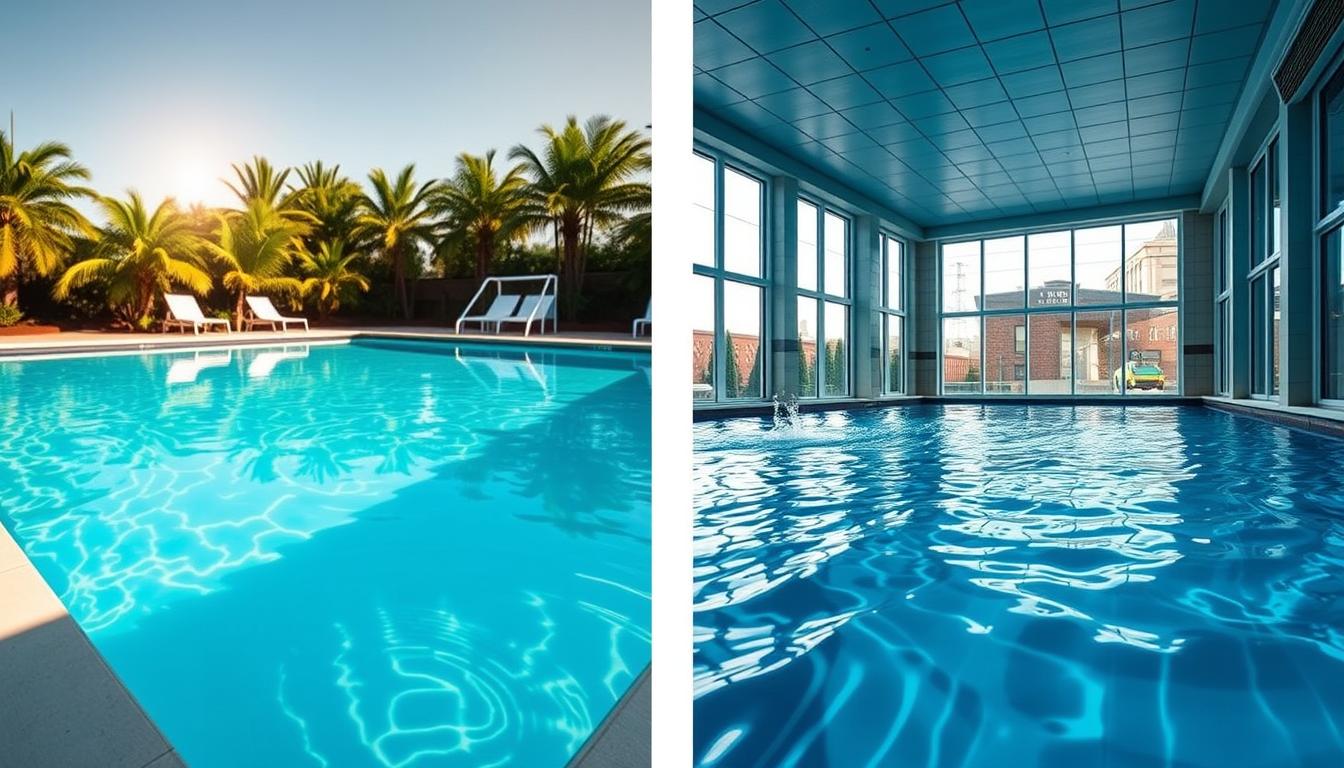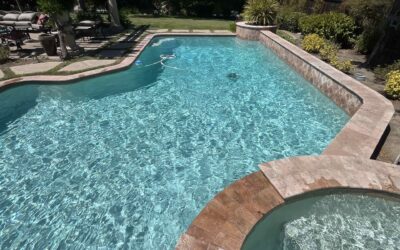Navigating the complex world of Indoor vs. Outdoor Commercial Pools demands comprehensive expertise. Our specialized approach considers multiple factors including climate, usage patterns, and operational costs that dramatically impact pool performance and sustainability.
Pools serve diverse purposes—from competitive training to recreational enjoyment. Understanding the intricate differences between indoor and outdoor pool designs enables facility managers to make informed decisions that optimize user experience, safety, and long-term operational efficiency.
The selection between indoor and outdoor commercial pools involves evaluating critical elements such as initial construction costs, maintenance expenses, environmental adaptability, and specific usage requirements. We will explore these dimensions comprehensively to provide actionable insights for pool professionals and decision-makers.
Our goal is to demystify the complexities of commercial pool construction and management, helping organizations create superior aquatic environments that meet their specific needs while maximizing user satisfaction and operational sustainability.
Key Differences Between Indoor and Outdoor Commercial Pools
Commercial pools present unique challenges and opportunities for design professionals. When exploring pool options, understanding the critical distinctions between indoor and outdoor pool designs becomes essential for creating optimal aquatic environments.
The spatial requirements for indoor pool design dramatically differ from outdoor pool configurations. Indoor pools typically range between 12 by 24 feet to 16 by 32 feet, constraining design possibilities. Outdoor pool designs offer significantly more flexibility, with potential sizes exceeding 20 by 40 feet and expanded landscaping opportunities.
Size and Space Considerations
Indoor pool design demands careful spatial planning. Structural limitations within buildings restrict pool dimensions, requiring innovative architectural solutions. Architects must balance available square footage with functional requirements, often creating compact yet efficient swimming spaces.
Climate and Seasonal Impacts
Outdoor pool design must account for seasonal variations and environmental challenges. While indoor pools maintain consistent temperatures through climate control systems, outdoor pools experience natural temperature fluctuations. Approximately 70% of indoor pool installations include comprehensive climate management technologies.
Aesthetic Appeal and Design Options
Outdoor pool design allows for more expansive aesthetic choices. Landscape integration, water features, and natural surroundings provide rich design possibilities. Indoor pools, restricted by architectural constraints, focus on creating sophisticated, controlled environments that maximize available space and architectural elements.
Understanding these fundamental differences helps businesses and designers make informed decisions about pool installations that meet specific functional and aesthetic requirements.
Maintenance Requirements for Indoor Pools
Managing an indoor commercial pool involves complex maintenance strategies that directly impact pool maintenance costs and pool energy efficiency. Our comprehensive approach ensures optimal performance and swimmer comfort in enclosed aquatic environments.
Indoor pools require specialized care due to their unique environmental constraints. Maintaining the right balance of water chemistry and air quality is crucial for creating a safe and enjoyable swimming experience.
Water Quality and Chemical Management
Precise chemical management is essential for indoor pools. We recommend maintaining water pH between 7.0 and 7.6 to prevent metal corrosion and ensure effective chlorine performance. Automatic dosing systems can help streamline chemical treatments, reducing manual intervention and improving overall pool maintenance costs.
Heating and Ventilation Needs
Efficient heating and ventilation are critical for indoor pool energy efficiency. Installing heat recovery ventilation units can significantly reduce energy consumption. Maintaining relative humidity between 40% and 60% prevents potential health risks and reduces equipment wear.
Regular Cleaning Procedures
Consistent cleaning protocols are vital for indoor pool environments. Weekly filter cleaning, regular skimming, and vacuuming help maintain water clarity and prevent bacterial growth. Professional pool operators should implement comprehensive cleaning schedules to minimize long-term maintenance expenses.
Maintenance Requirements for Outdoor Pools
Outdoor commercial pools present unique challenges that require strategic management and careful planning. Pool operators must navigate complex maintenance needs while ensuring optimal performance and swimmer safety throughout the year.
Seasonal Preparation Strategies
Effective pool heating systems play a crucial role in extending the usable season for outdoor pools. We recommend implementing comprehensive seasonal opening and closing protocols. This includes thorough cleaning, equipment inspection, and precise water chemistry balancing before winter and spring transitions.
Weather Protection Techniques
Pool insulation methods are essential for protecting against environmental fluctuations. Our approach involves using specialized covers, implementing drainage systems, and developing robust strategies to mitigate rain, wind, and temperature changes that could impact pool infrastructure.
Landscaping and Surrounding Area Management
Maintaining the pool’s surrounding landscape is critical for safety and aesthetic appeal. We focus on regular debris removal, proper drainage management, and creating a clean environment that enhances the overall swimming experience. Careful landscaping helps prevent water contamination and reduces maintenance challenges.
By integrating advanced pool heating systems and strategic pool insulation methods, commercial pool operators can maximize their outdoor pool’s functionality and minimize potential weather-related disruptions.
Advantages of Indoor Commercial Pools
Indoor commercial pools offer remarkable benefits that transform swimming experiences for businesses and recreational facilities. Our exploration reveals why these aquatic spaces have become increasingly popular across the United States.

Year-Round Swimming Accessibility
Indoor pools provide unparalleled swimming opportunities regardless of external weather conditions. With consistent temperatures and controlled environments, swimmers can enjoy aquatic activities throughout the year. This accessibility makes indoor pool design a strategic investment for businesses seeking to offer reliable recreational services.
Controlled Environment for Optimal Comfort
Pool energy efficiency reaches new heights within indoor settings. Precise temperature management ensures swimmers experience comfortable water and air conditions. Sophisticated ventilation systems help maintain ideal humidity levels between 50 to 60 percent, creating an ideal swimming atmosphere.
Reduced External Element Exposure
Indoor pools eliminate challenges associated with outdoor environments. By protecting swimmers from wind, debris, and sunlight variations, these facilities minimize maintenance requirements. Automatic pool covers can reduce evaporation by up to 50 percent, further enhancing pool energy efficiency and operational cost-effectiveness.
While initial construction costs range from $165,000 to $200,000, indoor pools offer long-term value. They can potentially increase property value by 5-10% and provide consistent, high-quality swimming experiences for users.
Advantages of Outdoor Commercial Pools
Outdoor commercial pools offer a unique swimming experience that combines natural beauty with recreational opportunities. These pools transform outdoor spaces into vibrant social hubs, providing an inviting environment for guests and patrons.
Natural Sunlight and Wellness Benefits
The power of natural sunlight sets outdoor pools apart from their indoor counterparts. Swimmers enjoy direct exposure to vitamin D, promoting overall health and wellness. An outdoor pool design can leverage sunlight to create a refreshing and energizing atmosphere that indoor pools simply cannot replicate.
Expanded Activity Capacity
Outdoor commercial pools excel in accommodating larger groups and diverse activities. From swimming lessons to community events, these pools provide flexible spaces that can host multiple simultaneous activities. Pool deck materials play a crucial role in creating functional and safe recreational areas.
Seamless Landscape Integration
Strategic outdoor pool design allows for beautiful integration with surrounding landscapes. Carefully selected pool deck materials can complement existing architectural elements, creating a cohesive and aesthetically pleasing environment. This approach transforms pools from mere water features into stunning centerpieces of outdoor spaces.
Our research indicates that outdoor pools can increase property value and attract more visitors by offering a dynamic, open-air swimming experience that appeals to diverse user groups.
Cost Considerations: Indoor vs. Outdoor Pools
When planning commercial pool construction, understanding the financial landscape is crucial. The costs associated with pools can vary dramatically, impacting long-term budgeting and operational strategies.
Initial Setup and Construction Expenses
Pool maintenance costs start with initial construction investments. An indoor pool typically ranges around $200,000, while outdoor pools can be more budget-friendly at $40,000 to $60,000. The construction complexity differs significantly between indoor and outdoor environments, influencing overall expenses.
Ongoing Maintenance Financial Considerations
Our analysis reveals that ongoing pool maintenance costs extend beyond basic cleaning. Factors like humidity control, heating systems, and water treatment contribute to substantial annual expenses. An indoor pool requires additional investments in dehumidification ($20,000-$30,000) and ventilation systems ($600-$1,100).
Insurance and Liability Impact
Commercial pool operators must factor in insurance premiums and potential liability risks. The pool type directly influences these financial considerations. Indoor pools might require more comprehensive insurance due to controlled environment complexities, while outdoor pools face weather-related risk assessments.
Strategic financial planning remains essential for successful pool management, considering both immediate and long-term economic implications of commercial pool construction.
Management Strategies for Indoor Pools
Managing indoor pools requires a comprehensive approach that balances safety, efficiency, and customer satisfaction. Our expertise in pool management focuses on creating exceptional swimming environments that meet rigorous pool safety regulations while maintaining top-notch indoor pool design standards.
Effective pool management begins with understanding the unique challenges of enclosed aquatic spaces. The complex interplay of water chemistry, air quality, and swimmer interactions demands specialized knowledge and proactive strategies.
Staffing and Lifeguard Responsibilities
Lifeguards play a critical role in maintaining safety within indoor pool environments. Our training programs emphasize constant vigilance, rapid response techniques, and comprehensive understanding of pool safety regulations. We prioritize staff education on advanced monitoring techniques, ensuring swimmer protection through skilled supervision.
Programming and Events Scheduling
Strategic programming maximizes indoor pool utilization throughout the year. We develop innovative scheduling approaches that cater to diverse swimmer needs, from lap swimming to group classes. Digital platforms now allow real-time monitoring and efficient management of pool activities, enhancing overall operational effectiveness.
Customer Experience Enhancement
Creating an exceptional swimming environment goes beyond basic maintenance. Our indoor pool design strategies focus on comfort, accessibility, and enjoyment. We implement advanced air quality management techniques to minimize chloramine buildup and ensure a pleasant atmosphere for swimmers of all ages.
By integrating cutting-edge technologies and comprehensive management protocols, we transform indoor pools into safe, inviting, and well-managed aquatic spaces that meet the highest industry standards.
Management Strategies for Outdoor Pools
Outdoor commercial pools require specialized management approaches that adapt to changing environmental conditions. Our experience with pool safety regulations demonstrates the critical importance of comprehensive seasonal planning. From staffing to water quality control, successful outdoor pool design demands strategic attention to multiple complex factors.
Seasonal staffing presents unique challenges for outdoor pool management. We recommend developing robust training programs that prepare lifeguards and maintenance personnel for varied weather conditions. Comprehensive certification in CPO training ensures staff can effectively manage pool chemical levels and handle unexpected situations with professional expertise.
Community Engagement and Marketing
Effective marketing strategies can transform an outdoor pool from a simple recreational facility into a community centerpiece. We focus on creating engaging programs that highlight the pool’s unique features, using social media and local partnerships to attract diverse user groups. Understanding local demographics helps us design targeted initiatives that increase pool usage and community involvement.
Health and Safety Compliance
Strict adherence to pool safety regulations is non-negotiable in outdoor pool management. Our team implements rigorous inspection protocols that address water quality, structural integrity, and chemical balance. With annual water loss from public in-ground pools reaching 160,000 gallons, we prioritize efficient water management techniques that simultaneously maintain safety and sustainability.
Strategic Management Conclusion
Successful outdoor pool management requires a holistic approach that balances technical expertise, community engagement, and regulatory compliance. By implementing comprehensive strategies, pool operators can create safe, enjoyable aquatic environments that serve their communities effectively throughout the operating season.
Source Links
- https://ilpools.ae/indoor-swimming-pools/ – Indoor Swimming Pools: Design, Benefits, and Maintenance
- https://xlpools.com/pool-construction-types/ – Pool Construction Types – Swimming Pool Technical Guides
- https://www.bluecubepools.co.uk/blog/indoor-vs-outdoor-pools-which-should-you-buy/ – Indoor vs Outdoor Pools: Which Should You Buy? | Blue Cube Pools
- https://www.fluidra.com/projects/commercial-swimming-pools/ – Commercial swimming pools: all you need to know – Fluidra
- https://pooloperationmanagement.com/indoor-pool-maintenance-guide-air-circulation/ – Indoor Pool Maintenance Guide: Air Circulation For Indoor Pools
- https://www.compass-pools.co.uk/learning-centre/news/the-complete-guide-to-swimming-pool-maintenance/ – The Complete Guide to Swimming Pool Maintenance | Compass Pools
- https://www.premierpools.com.au/indoor-pool-vs-outdoor-pool/ – Indoor Pool vs Outdoor Pool – Premier Pools – Sydney
- https://blog.chloramineconsulting.com/commercial-pools-and-their-differences – Commercial Pools and their Differences
- https://www.cityofsouthlake.com/DocumentCenter/View/41348/Pool-Guidelines-Mar-2024 – PDF
- https://www.duanesburg.net/building-department/files/swimming-pool-requirements – PDF
- https://www.riverpoolsandspas.com/blog/indoor-swimming-pools-101-cost-construction-advantages-common-questions – Indoor Swimming Pools 101: Cost, Construction, Advantages, & More!
- https://www.marylandsunrooms.com/blog/outdoor-pool-vs-indoor-pool/ – Outdoor Pool vs. Indoor Pool: Which to Choose
- https://luxurypools.com/guides/indoor-pools/ – The Ultimate Guide To Indoor Pools: What You Need to Know
- https://www.compass-pools.co.uk/learning-centre/news/indoor-or-outdoor-how-to-choose-your-pool/ – Indoor vs Outdoor Swimming Pool : How To Choose Your Pool | Compass Pools
- https://www.sandiegopools.com/benefits-of-indoor-pools/ – Is It a Good Idea to Have an Indoor Pool?
- https://www.jbeliteservices.co.uk/pros-and-cons-of-heating-indoor-or-outdoor-pools-during-off-seasons/ – Pros And Cons Of Heating Indoor Or Outdoor Pools During Off Seasons
- https://www.riverpoolsandspas.com/blog/indoor-vs-outdoor-pools-costs-considerations-faqs – Indoor vs. Outdoor Pools: Costs, Considerations, FAQs
- https://recmanagement.com/articles/154613/realistic-pool-pricing-city-commercial-pools – Realistic Pool Pricing for City & Commercial Pools | Recreation Management
- https://parrishpools.com/a-guide-to-commercial-swimming-pool-construction-costs/ – A Guide to Commercial Swimming Pool Construction Costs
- https://blog.poolsharkh2o.com/commercial-pool-chlorine-management – Commercial Pool Chlorine Management
- https://parrishpools.com/planning-a-commercial-pool-project/ – Planning a Commercial Pool Project – Parrish Pools – Commercial Pool Builders
- https://www.epa.gov/system/files/documents/2023-11/ws-commercial-bmp-watersenseatwork_section5.3_commercialpoolsandspas.pdf – WaterSense at Work Section 5.3: Commercial Pool and Spa Equipment
- https://thecpsa.org/blog/indoor-vs-outdoor-pool/ – Indoor and Outdoor Pool: Costs, Maintenance & Considerations
- https://www.kieferusa.com/blog/indoor-sports-facilities-pool-and-wet-floor-maintenance-tips/ – Indoor Sports Facilities: Pool and Wet Floor Maintenance Tips





